Big data platforms are scalable, fault-tolerant systems that manage and process massive, diverse data for fast, integrated analytics.
Here are 10 best big data platforms that you can try to explore :
- Fanruan
- Tableau
- Apache Hadoop
- Apache Spark
- Google BigQuery
- Amazon EMR
- Microsoft Azure Synapse Analytics
- Snowflake
- Cloudera Data Platform
- Splunk
Big data platforms have become essential for businesses navigating the complexities of 2025. With approximately 75% of companies adopting big data analytics by 2027, these tools are no longer optional—they are a necessity. They empower you to process vast amounts of information, from customer interactions to sensor data, enabling real-time insights that drive smarter decisions. By leveraging these platforms, you can identify trends, predict market shifts, and foster innovation. AI-powered solutions further enhance this process, allowing teams to experiment and align strategies dynamically. To stay competitive, exploring the right tools tailored to your needs is critical.
What Are Big Data Platforms and Tools?
Overview of Big Data Platforms
Big data platforms are comprehensive systems designed to manage, process, and analyze vast amounts of structured and unstructured data. These platforms address the challenges of big data, including its volume, variety, and velocity. They integrate seamlessly with existing systems like databases and business intelligence applications, ensuring smooth data workflows. Scalability is a defining feature, allowing you to handle petabytes of data without overhauling your infrastructure. Additionally, these platforms offer fault tolerance, enabling continuous operation even during hardware failures.
Modern big data platforms also emphasize distributed processing, where tasks are divided across multiple nodes for efficiency. This approach ensures faster data analysis and supports real-time data processing. With advanced analytics and visualization tools, these platforms empower you to uncover actionable insights and optimize operations. Whether you're managing a cloud-based data warehouse or a hybrid system, big data platforms provide robust solutions for data storage, processing, and analysis.
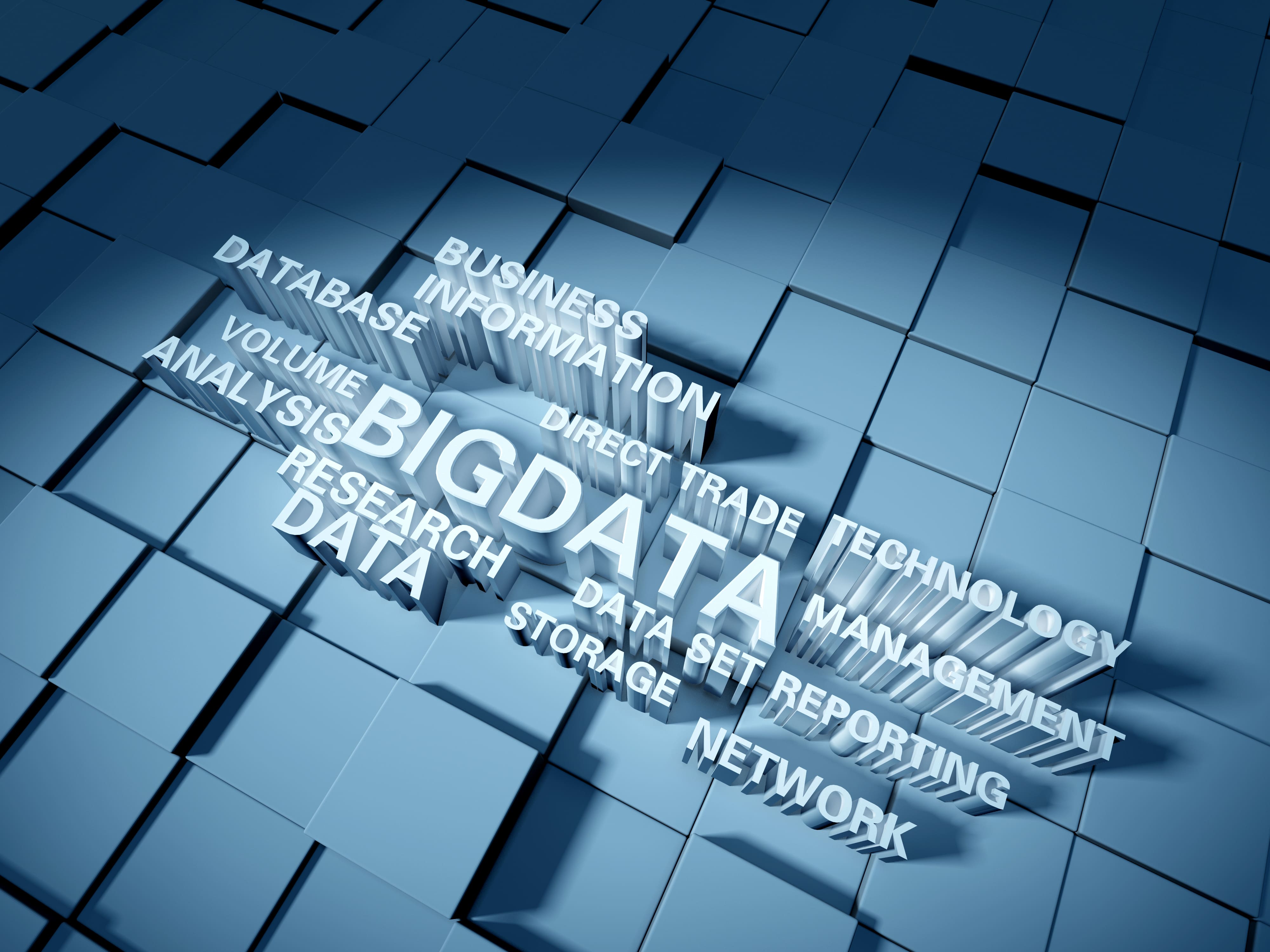
Overview of Big Data Tools
Big data tools are specialized software solutions that complement platforms by focusing on specific aspects of data management and analysis. These tools streamline data transformation workflows, enhance data integration, and improve processing efficiency. For instance, data engineering tools help you prepare raw data for analysis, while data analytics tools enable you to extract meaningful insights.
Some tools focus on real-time data processing, making them ideal for applications like threat detection and system optimization. Others specialize in data visualization, helping you present complex information in an accessible format. By combining the right tools with a reliable data platform, you can create a powerful ecosystem for managing and analyzing data effectively.
The Role of Big Data Platforms and Tools in 2025
In 2025, big data platforms and tools will play a pivotal role in driving data-driven strategies. Businesses will rely on these solutions to manage and analyze growing volumes of data efficiently. Advanced data analytics tools will enable you to make data-driven decisions, shifting from reactive to proactive approaches. This shift will help you anticipate customer needs and gain a competitive edge.
Emerging trends like data lakehouses and open table formats will redefine data warehousing, combining flexibility with reliability. Cloud-based big data platforms will dominate, offering scalability and seamless integration with cloud computing ecosystems. Additionally, the integration of AI and semantic layers into data platforms will enhance contextual data analysis, paving the way for smarter decision-making. By leveraging these advancements, you can stay ahead in a data-driven world.
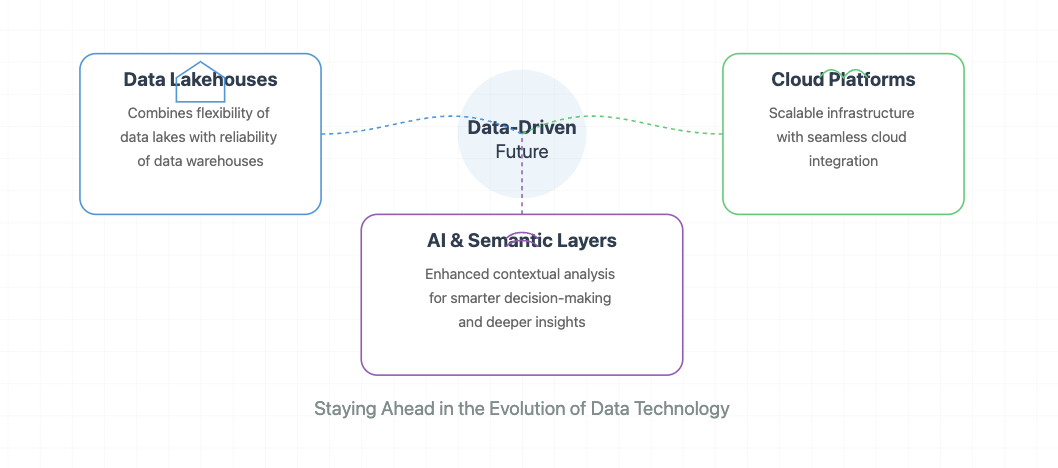
Key Features to Look For in Big Data Platforms and Tools
Scalability for Growing Data Needs
Scalability is one of the most critical features of big data platforms. FineBI excels in scalability, offering a flexible architecture that grows with your business needs. Unlike platforms like Apache Hadoop, which require significant infrastructure investment, FineBI provides a cost-effective and user-friendly solution for businesses of all sizes.
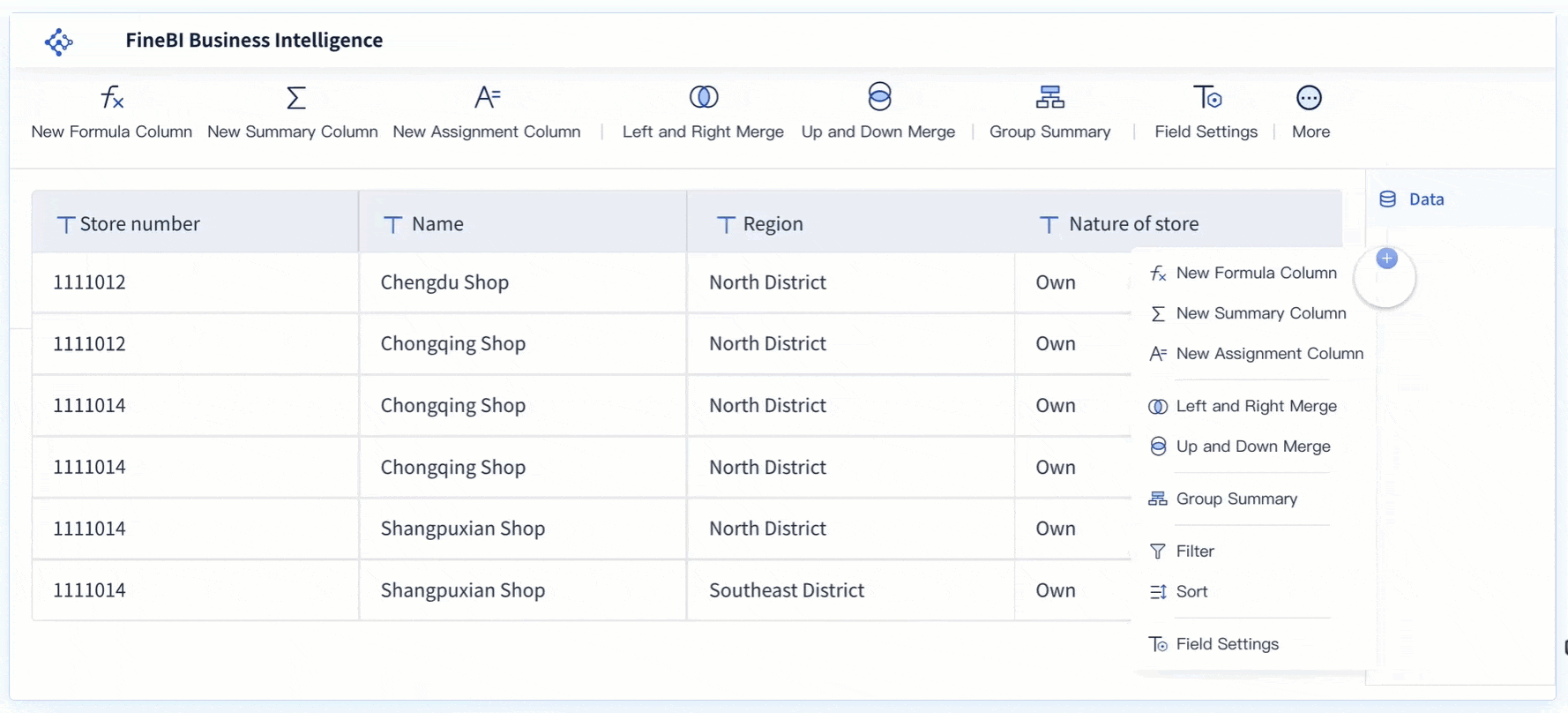
As your business grows, so does the volume of data you need to manage. A scalable platform ensures that you can handle increasing data volumes without compromising performance. For instance, distributed processing allows tasks to be divided across multiple nodes, making it easier to process large datasets efficiently. Platforms with scalable architectures also support real-time analytics, which is essential for timely decision-making.
Modern solutions like data lakes and distributed systems provide the flexibility to store and access unstructured data seamlessly. They also enable dynamic resource allocation, ensuring efficient data processing as your needs evolve. By choosing a scalable platform, you can future-proof your data management strategy and maintain operational efficiency even as your data grows.
Speed and Efficiency in Data Processing
Speed and efficiency are vital for big data analytics. Businesses rely on fast data processing to gain real-time insights and make informed decisions. Big data platforms achieve this through advanced data engineering tools that optimize workflows and reduce processing times. Distributed systems play a key role here, as they allow parallel processing across multiple nodes, significantly enhancing performance.

Efficient platforms also incorporate features like data indexing and caching to accelerate query responses. These capabilities are particularly useful for large-scale analysis, where delays can impact business outcomes. By prioritizing speed and efficiency, you can ensure that your data analytics tools deliver actionable insights when you need them most.
Integration with Existing Systems
Seamless integration with existing systems is crucial for the success of any big data platform. To achieve this, you need to assess your current enterprise architecture and define clear business objectives. The right platform should align with your technical and operational needs, ensuring compatibility with your existing databases, applications, and workflows.
Integration involves designing connection points between your systems and the new platform. This process includes implementing data governance policies to maintain data quality and security. Real-time analytics capabilities further enhance integration by enabling immediate insights from your data. Continuous monitoring and optimization ensure that the integration remains effective over time. By focusing on integration, you can create a cohesive data ecosystem that supports your business goals.

Security and Compliance Standards
When choosing big data platforms, security and compliance should be your top priorities. These platforms handle sensitive information, making robust security measures essential. Compliance with global standards ensures that your data management practices align with legal and ethical requirements.
| Compliance Standard | Description | Key Points |
|---|---|---|
| GDPR | Comprehensive EU regulation on personal data protection. | Rights to access, rectification, deletion; non-compliance leads to fines. |
| HIPAA | US regulation for medical personal information protection. | Rigid guidelines for patient confidentiality; audit requirements. |
| CCPA | California law giving consumers control over their data. | Transparency in data practices; fines for non-compliance. |
| PCI DSS | International standard for credit card information security. | Requires encryption and multi-factor authentication; penalties for breaches. |
| SOX | US law for financial reporting accuracy. | Strict data management standards; promotes transparency and accountability. |
Big data platforms must integrate encryption, multi-factor authentication, and real-time monitoring to protect your data. These features help prevent breaches and ensure compliance with standards like GDPR and HIPAA. By prioritizing security, you can build trust with your customers and safeguard your business.
Cost-Effectiveness for Businesses
Cost-effectiveness is a critical factor when selecting big data platforms. You need a solution that delivers value without straining your budget. Cloud-based platforms often provide flexible pricing models, allowing you to pay only for the resources you use. This approach reduces upfront costs and makes scaling more affordable.
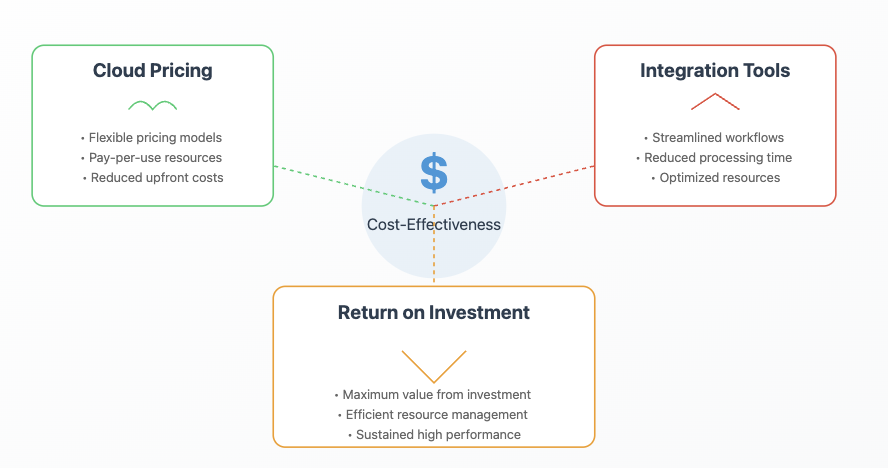
Platforms that integrate data engineering tools can also save you money. These tools streamline workflows, reducing the time and resources needed for data processing. For example, distributed systems optimize resource allocation, ensuring efficient data management. By choosing a cost-effective platform, you can maximize your return on investment while maintaining high performance.
User-Friendliness and Accessibility
A user-friendly platform ensures that you can leverage big data analytics without requiring advanced technical skills. Look for platforms with intuitive interfaces and drag-and-drop functionality. These features simplify navigation and make data analytics tools accessible to non-technical users.
- Intuitive interfaces that allow easy navigation.
- Drag-and-drop functionality for ease of use.
- Customizable dashboards tailored to user preferences.
- Robust data visualization capabilities to simplify data interpretation.
- Self-service analytics features that do not require coding skills.
As a non-technical user, having access to support resources is vital. Look for platforms that offer comprehensive tutorials, help forums, and customer service. These resources can be invaluable when you encounter a hurdle.
Platforms like Tableau and Microsoft Power BI excel in this area. They offer visually engaging charts and graphs, helping you interpret data quickly. Customizable dashboards further enhance usability, empowering you to extract insights confidently. By prioritizing accessibility, you can ensure that your team fully utilizes the platform's capabilities.

Top 10 Big Data Platforms and Tools in 2025
1.Fanruan
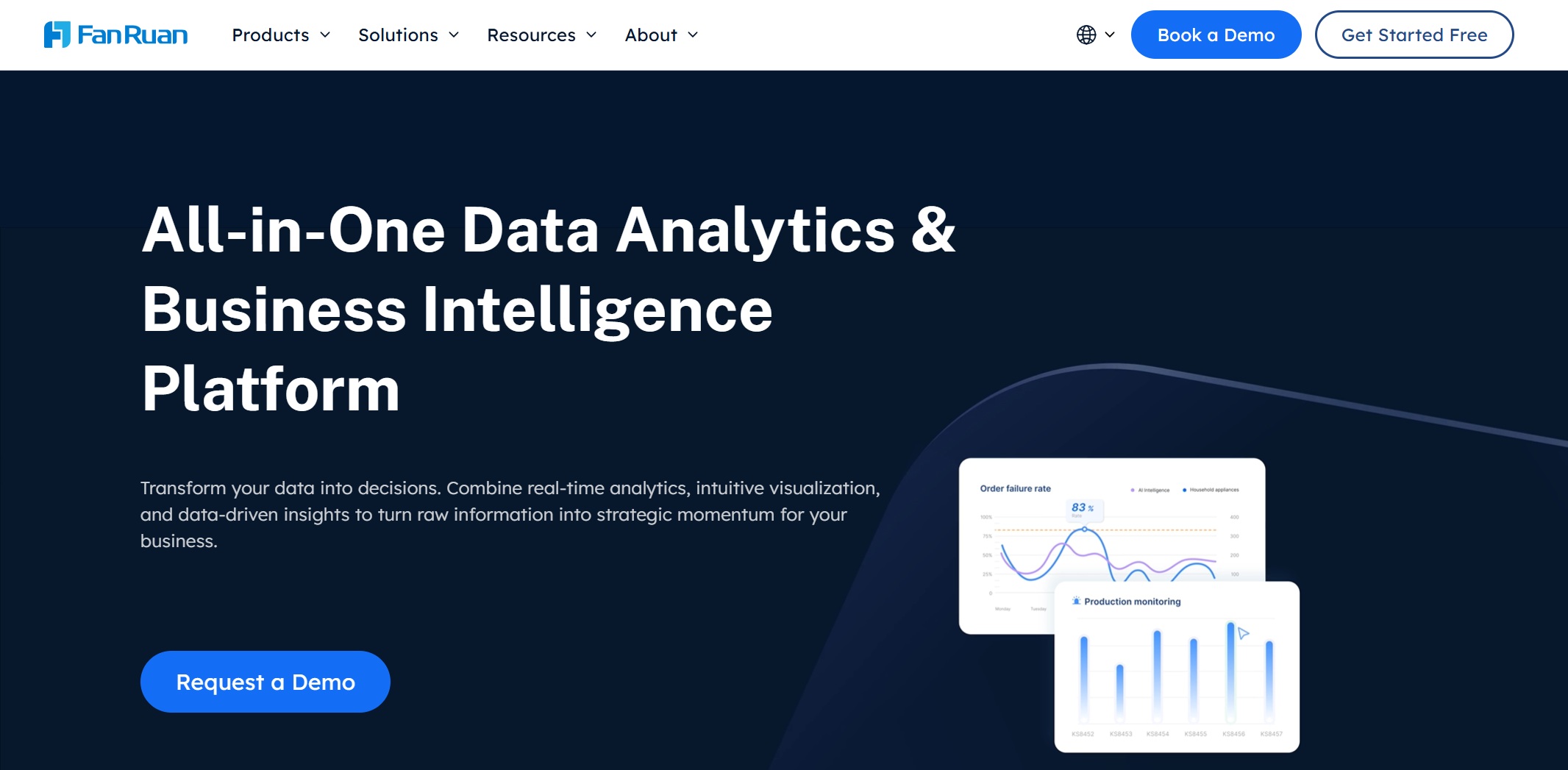
Website: https://www.fanruan.com/en
Fanruan, a prominent player in the big data and business intelligence (BI) landscape, has gained significant traction for its innovative and user-centric approach to data analytics and visualization. With a focus on empowering organizations to harness the power of their data, Fanruan offers a suite of tools designed to simplify complex data processes while delivering actionable insights. Among its flagship products, FineBI stands out as a powerful and accessible BI platform that caters to businesses of all sizes.
Key Features
- Seamless Integration
Fanruan’s solutions are designed to integrate effortlessly with existing systems, including ERP, CRM, and other enterprise software. This ensures minimal disruption to workflows while maximizing data utility. - Scalable Architecture
Built to handle growing data demands, Fanruan’s platforms are highly scalable, making them suitable for both small businesses and large enterprises. - Real-Time Data Processing
Fanruan’s real-time analytics capabilities enable businesses to make data-driven decisions instantly, a critical feature for industries like e-commerce, logistics, and finance. - Customizable Dashboards
Users can create tailored dashboards to meet specific business needs, ensuring that the most relevant insights are always at their fingertips. - Advanced Data Visualization
Fanruan offers a wide range of visualization options, from simple charts to complex interactive reports, making it easier to interpret and present data.
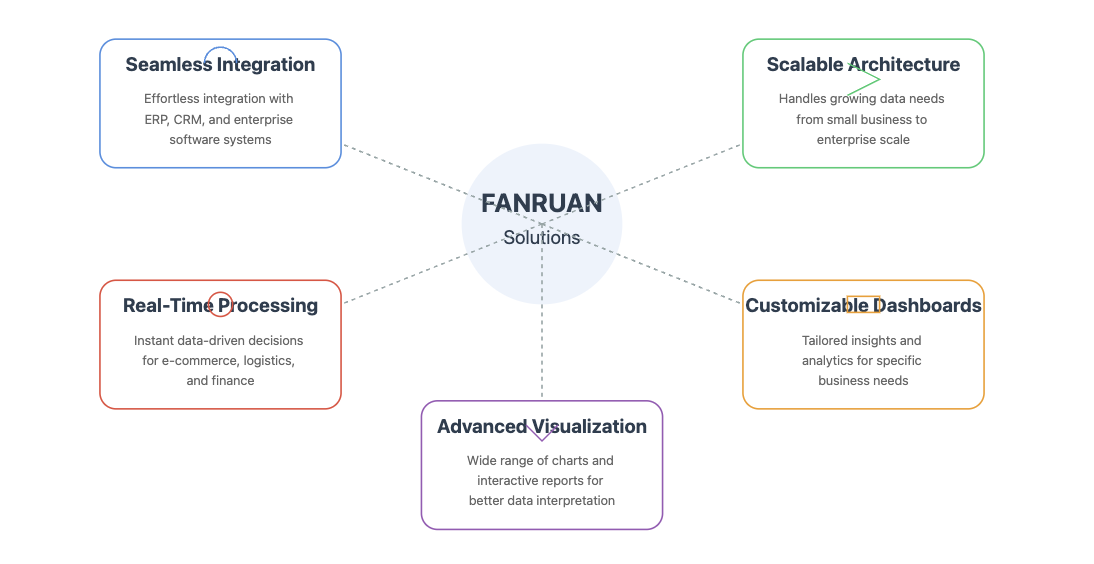
Use Cases
Financial Analysis
Fanruan’s FineBI is a game-changer in financial analysis, offering organizations a powerful yet intuitive platform for budgeting, forecasting, and financial reporting. Unlike traditional BI tools like Tableau or Power BI, FineBI excels in real-time data processing, allowing finance teams to make swift, data-driven decisions with up-to-the-minute accuracy. Its user-friendly, drag-and-drop interface empowers non-technical users to create detailed financial models and reports without relying on IT support, reducing time-to-insight significantly.
Additionally, FineBI’s affordability makes it an attractive option for small to medium-sized businesses that need advanced financial analytics without the high costs associated with competitors like QlikView. With its scalability, real-time capabilities, and emphasis on self-service analytics, FineBI is the ideal tool for organizations aiming to enhance their financial planning and reporting processes efficiently.
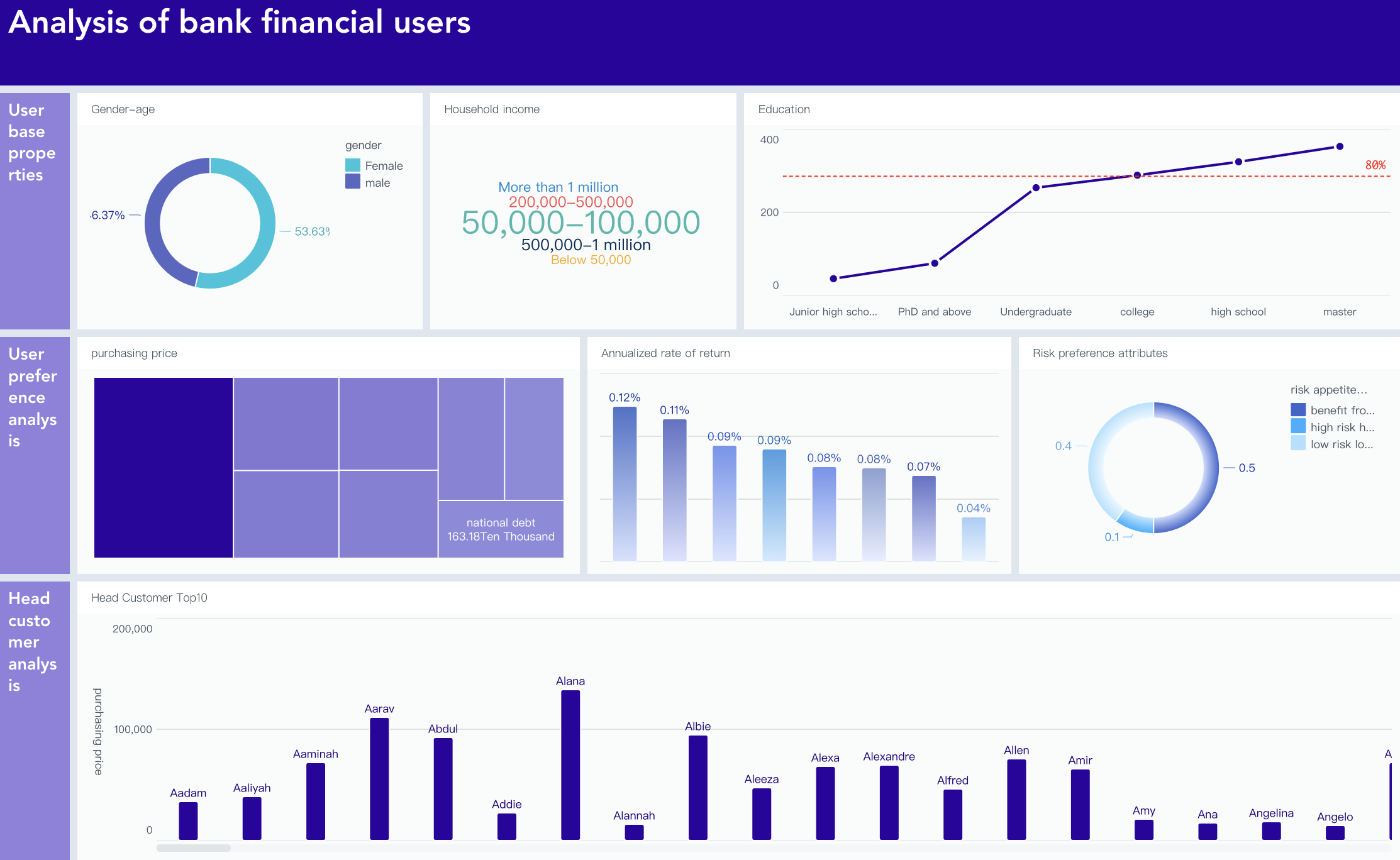
E-Commerce and Retail
Fanruan’s FineBI revolutionizes e-commerce and retail with real-time data processing and intuitive visualization tools, empowering businesses to monitor sales, track customer preferences, and manage operations efficiently. Unlike Tableau or Power BI, FineBI’s user-friendly, drag-and-drop interface enables non-technical teams to create dynamic dashboards without extensive training, speeding up decision-making. Its real-time analytics allows instant responses to market trends, inventory changes, and customer behavior, providing a competitive edge.
FineBI seamlessly integrates with e-commerce platforms and CRM systems, centralizing data and eliminating silos. Customizable dashboards offer insights into key metrics like conversion rates and customer lifetime value, optimizing marketing and retention strategies. Affordable and scalable, FineBI supports businesses of all sizes, enabling self-service analytics that reduce IT dependency. With advanced visualizations and simplified workflows, FineBI helps retailers drive growth and enhance customer satisfaction in a fast-paced market.
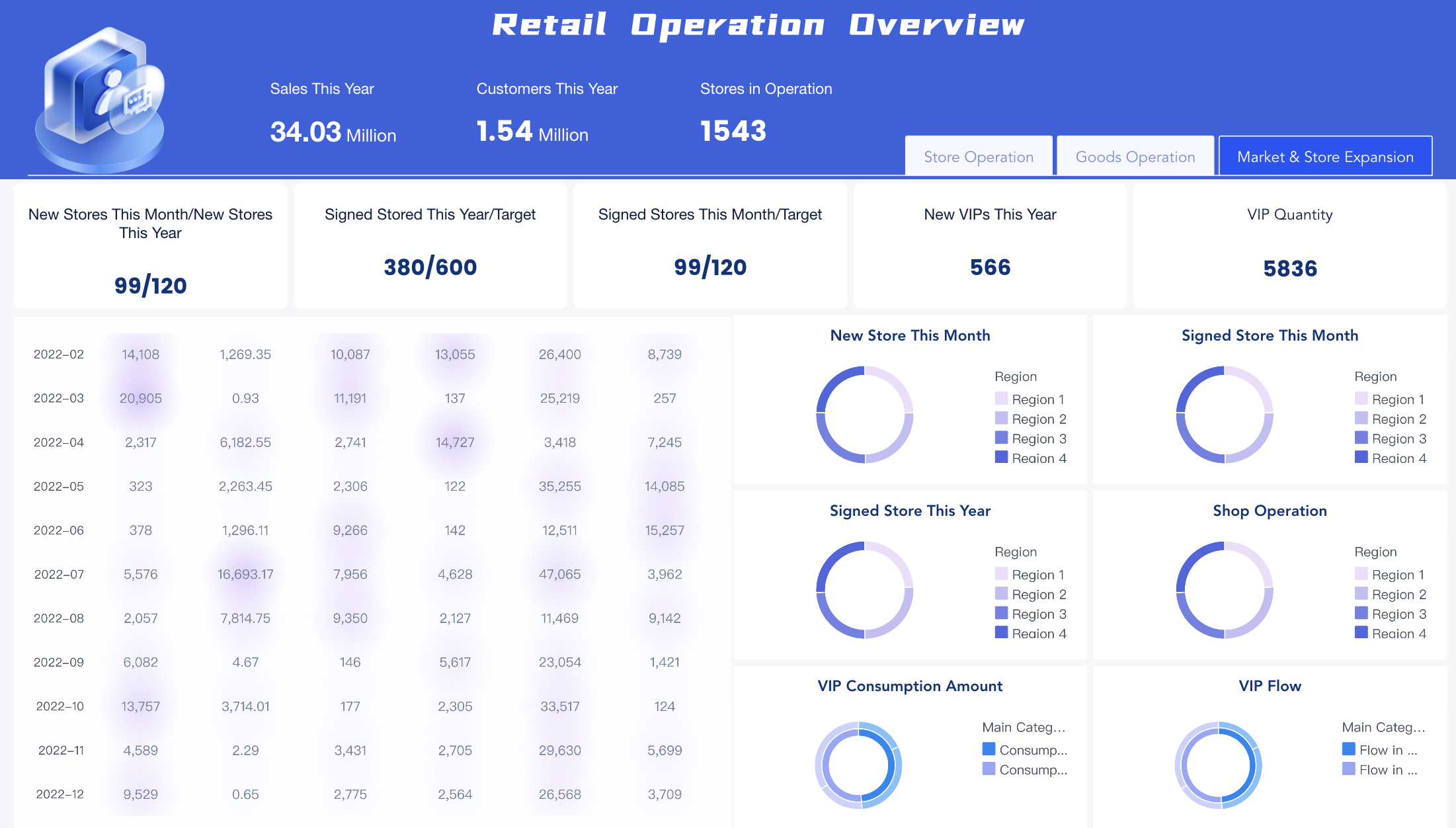
Pros and Cons
Pros:
- Affordable Pricing
FineBI offers a cost-effective alternative to other BI tools on the market, making advanced data analytics accessible to small and medium-sized businesses. - User-Friendly Interface
With an intuitive drag-and-drop interface, FineBI minimizes the learning curve, allowing users to quickly get up to speed and start deriving insights. - Strong Focus on Real-Time Analytics
FineBI’s real-time processing capabilities ensure that businesses can react swiftly to changing conditions, making it ideal for dynamic industries.
Cons:
- Limited global presence and community support.
- Fewer advanced features compared to Tableau.
Despite its limited global presence, FineBI’s growing user base and extensive documentation are bridging the gap. Additionally, its affordability and ease of use make it a strong contender against more established platforms like Tableau and Power BI.
2.Tableau

Website: https://www.tableau.com/
Key Features
Tableau stands out as one of the most versatile big data platforms, offering advanced data visualization tools and analytics capabilities. Its key features include:
- Informative dashboards that provide a clear overview of your data.
- Connectivity with live and in-memory data for real-time insights.
- Support for numerous data sources, ensuring seamless integration.
- Advanced visualization capabilities, including trend lines and predictive analysis.
- A mobile version for on-the-go access.
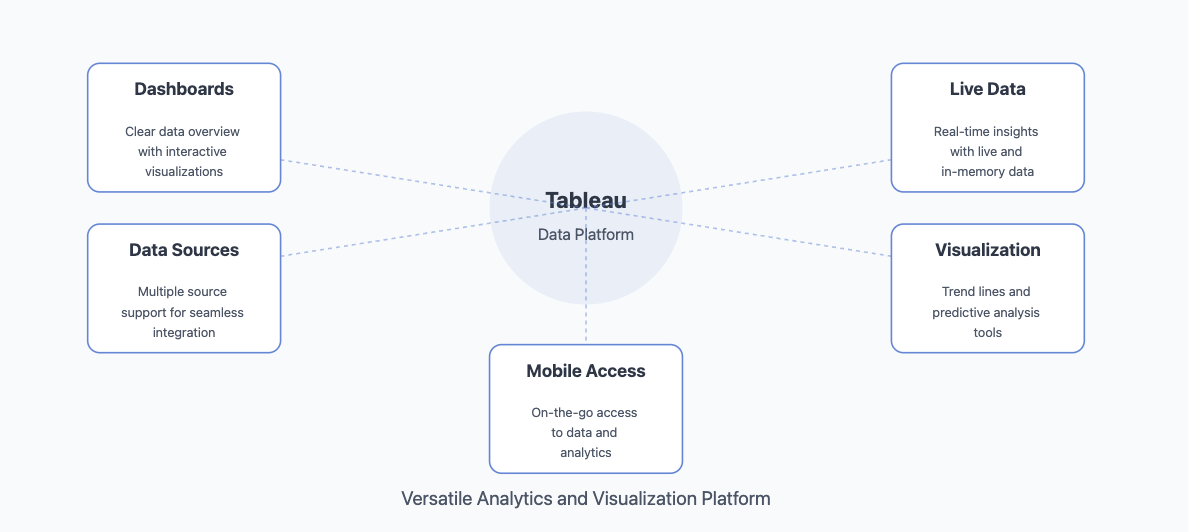
These features make Tableau a leader in big data analytics, enabling you to transform raw data into actionable insights effortlessly.
Use Cases
Tableau excels in industries requiring robust data visualization. Businesses use it for sales forecasting, customer segmentation, and performance tracking. Marketing teams rely on its interactive dashboards to monitor campaign effectiveness. Additionally, its predictive analytics capabilities help organizations anticipate trends and make proactive decisions.
Pros and Cons
Pros:
- Intuitive interface suitable for non-technical users.
- Strong data visualization capabilities.
- Excellent community support and resources.
Cons:
- High licensing costs for small businesses.
- Limited customization options for advanced users.
While Tableau excels in data visualization, FineBI offers a more balanced approach by combining real-time analytics, seamless integration, and affordability. FineBI’s focus on self-service BI makes it a more accessible option for businesses that need both advanced analytics and ease of use.
3.Apache Hadoop
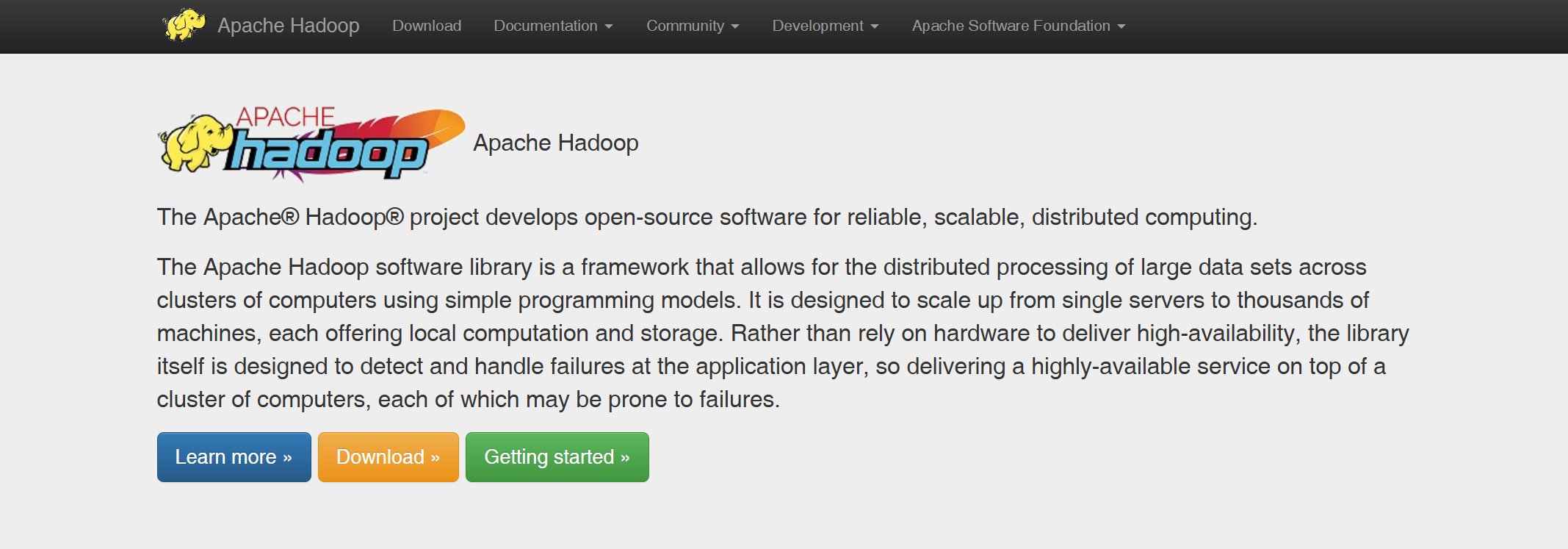
Website: https://hadoop.apache.org/
Key Features
Apache Hadoop remains a cornerstone in big data platforms, known for its scalability and reliability. Its features include:
- Distributed storage and processing for handling massive datasets.
- Fault-tolerant architecture ensuring uninterrupted operations.
- Integration with various data engineering tools for efficient workflows.
- Open-source framework with extensive community support.
Hadoop's ability to process petabytes of data makes it indispensable for large-scale data analytics.
Use Cases
Hadoop is widely used in retail analytics for inventory forecasting, dynamic pricing, and supply chain optimization. Financial institutions leverage it for risk assessment by aggregating data from multiple sources. In healthcare, Hadoop supports the analysis of medical data to develop personalized treatments and monitor public health trends.

Pros and Cons
Pros:
- Highly scalable for growing data needs.
- Cost-effective due to its open-source nature.
- Strong community support for troubleshooting and development.
Cons:
- Steep learning curve for new users.
- Requires significant infrastructure investment for optimal performance.
These platforms highlight the diversity of big data tools available in 2025. Each offers unique strengths, catering to different business needs. Which one aligns with your goals? Share your thoughts in the comments below!
4.Apache Spark
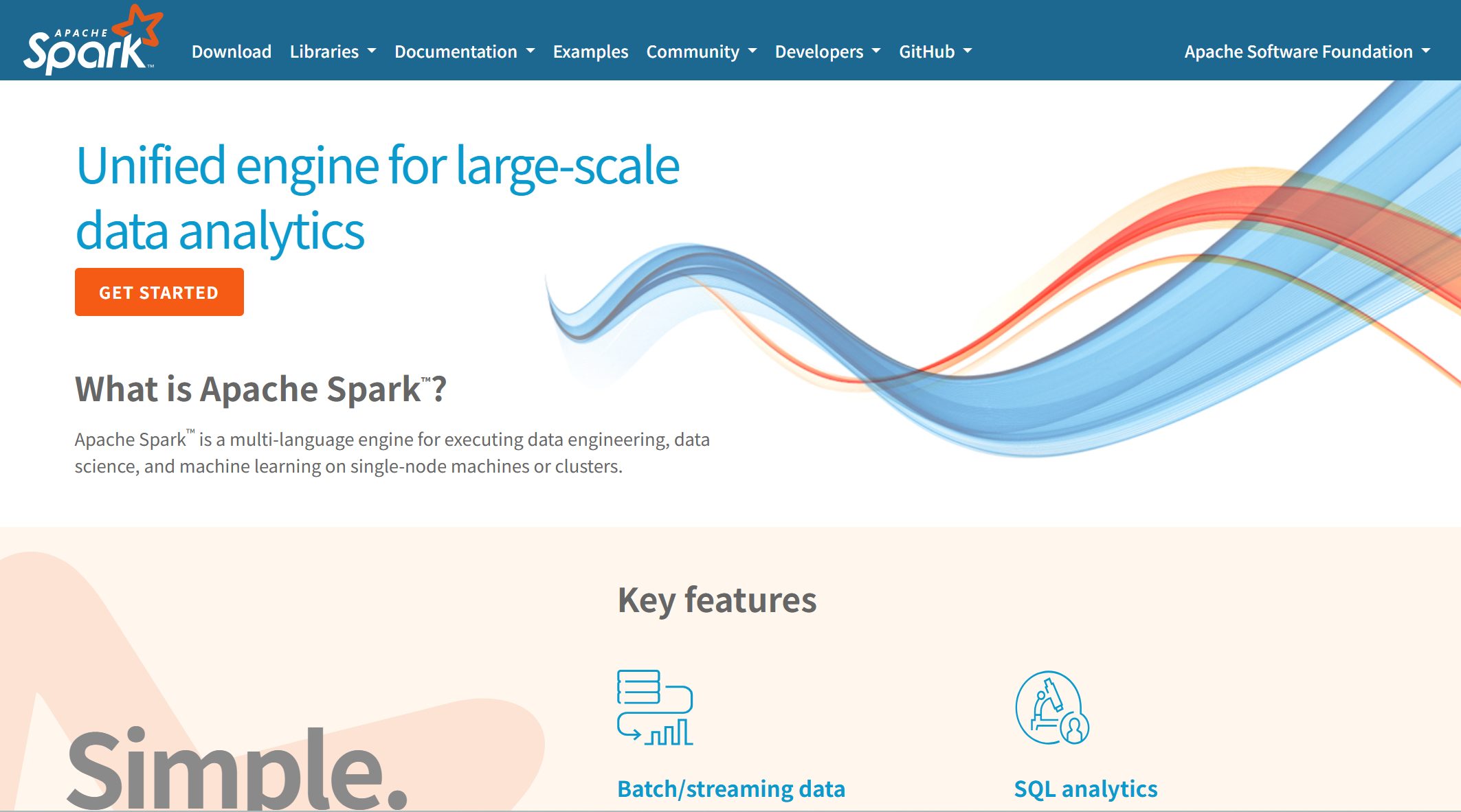
Website: https://spark.apache.org/
Key Features
Apache Spark is a powerful tool for big data analytics, offering advanced capabilities that enhance data processing for businesses. Its key features include:
- Advanced Analytics: Spark provides libraries for structured data processing, machine learning, graph processing, and real-time analytics.
- In-memory Processing: This feature reduces read/write operations by storing data during jobs, significantly speeding up processing times.
- Faster Query Execution: Spark's execution engine is more flexible than MapReduce, enabling more efficient operations.
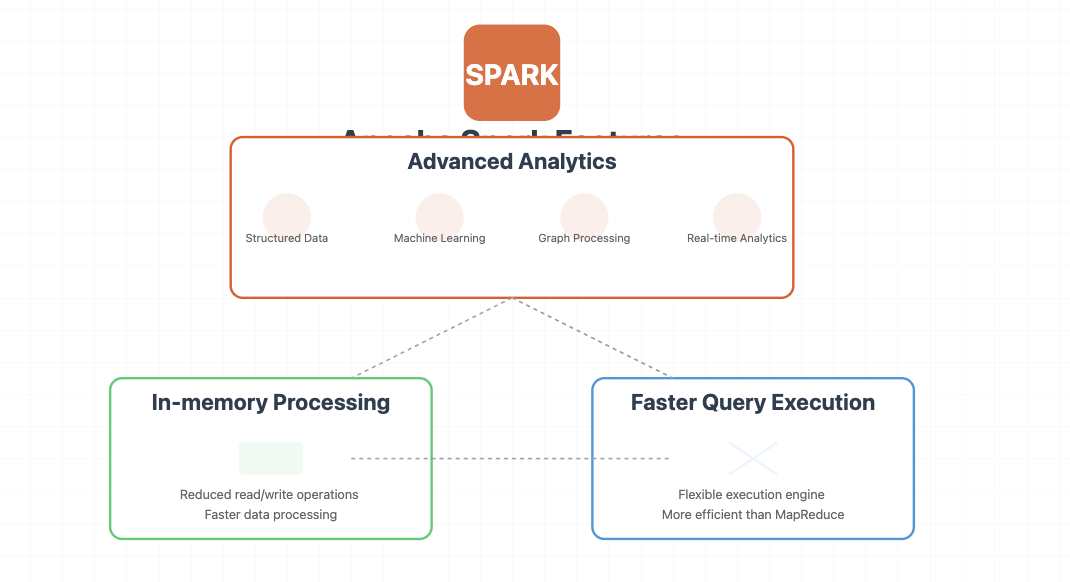
These features make Apache Spark a go-to choice for businesses seeking speed and efficiency in their data analytics workflows.
Use Cases
Apache Spark is widely used across industries for various applications. Retailers use it to analyze customer behavior and optimize inventory management. Financial institutions rely on Spark for fraud detection and risk analysis. In healthcare, Spark supports real-time patient monitoring and predictive analytics for personalized treatments. Its ability to process large datasets quickly makes it ideal for scenarios requiring immediate insights.
Pros and Cons
Pros:
- Exceptional speed due to in-memory processing.
- Versatile libraries for diverse analytics tasks.
- Strong community support and open-source nature.
Cons:
- Requires significant memory resources for optimal performance.
- Steep learning curve for beginners.
5.Google BigQuery
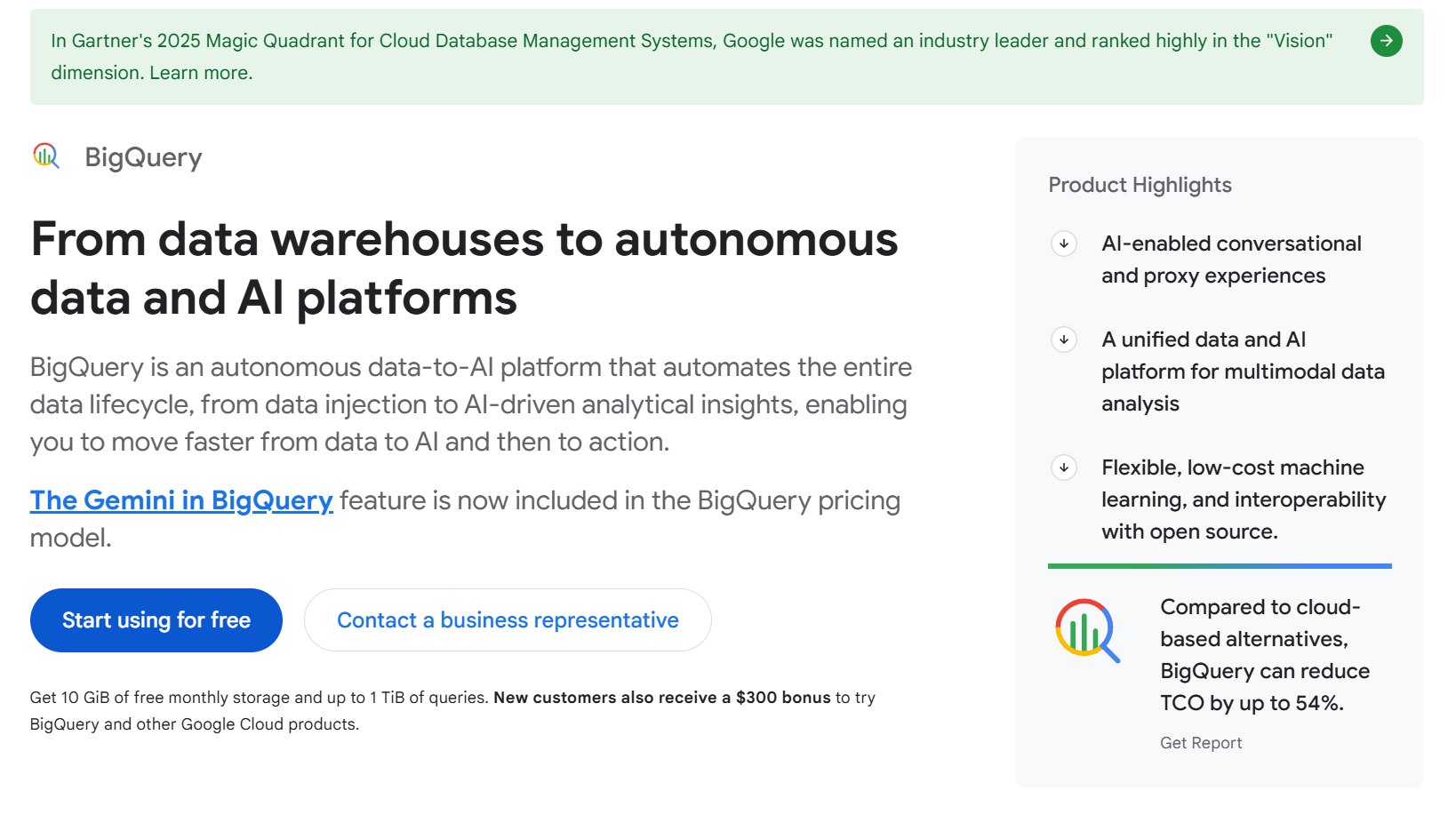
Website: https://cloud.google.com/bigquery
Key Features
Google BigQuery is a cloud-based big data platform designed for fast and scalable data analytics. Its standout features include:
- The ability to query raw data without sampling.
- User-level analysis instead of session-based metrics.
- Combining multiple dimensions and metrics in a single query.
- Dynamic adjustments to historical data for correcting past tracking errors.
- Integration with additional data sources for comprehensive insights.
BigQuery also supports exporting data for visualization and works seamlessly with various business intelligence tools.

Use Cases
BigQuery is ideal for businesses needing real-time insights from large datasets. Marketing teams use it to analyze campaign performance and customer engagement. E-commerce companies rely on it for inventory forecasting and dynamic pricing. Its ability to handle complex queries efficiently makes it a favorite among data-driven organizations.
Pros and Cons
Pros:
- Scalable and fast for large-scale data analytics.
- Seamless integration with Google Cloud and BI tools.
- User-friendly interface for non-technical users.
Cons:
- Costs can escalate with high query volumes.
- Limited offline functionality.
6.Amazon EMR
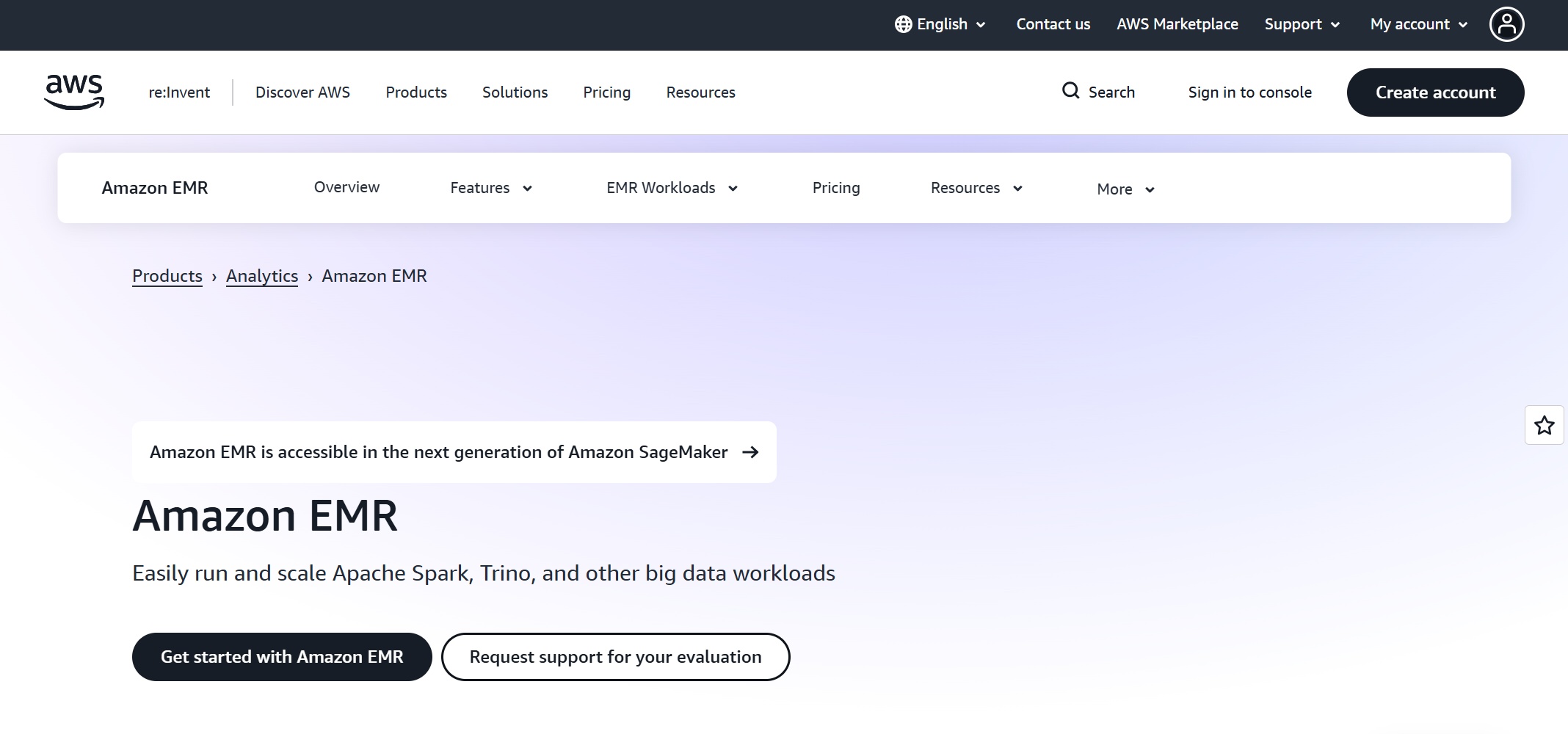
Website: https://aws.amazon.com/emr/
Key Features
Amazon EMR (Elastic MapReduce) simplifies big data processing with its scalable and managed environment. Key features include:
| Feature | Description |
|---|---|
| Managed Clusters | Simplifies cluster management, allowing you to focus on data processing rather than infrastructure. |
| Scalability | Dynamically adjusts the cluster’s EC2 instance count based on workload needs. |
| Integrated Big Data Frameworks | Supports technologies like Apache Spark, Hadoop, Hive, and others for large data processing. |
| Flexibility in Instance Types | Offers a variety of Amazon EC2 instance types to meet different processing requirements. |
| Managed Environment | Reduces administrative costs by managing environment provisioning and configuration. |
These features make Amazon EMR a reliable choice for businesses looking to scale their big data analytics operations.
Use Cases
Amazon EMR is widely used in industries requiring scalable data processing. Media companies use it for real-time content recommendations. Financial institutions rely on it for risk modeling and fraud detection. Its ability to handle diverse workloads makes it suitable for both batch and real-time data analytics.
Pros and Cons
Pros:
- Highly scalable for growing data needs.
- Supports a wide range of big data frameworks.
- Reduces administrative overhead with managed services.
Cons:
- Costs can increase with complex workloads.
- Requires expertise to configure and optimize clusters.
Which of these big data platforms aligns with your business needs? Share your thoughts in the comments below!
7.Microsoft Azure Synapse Analytics
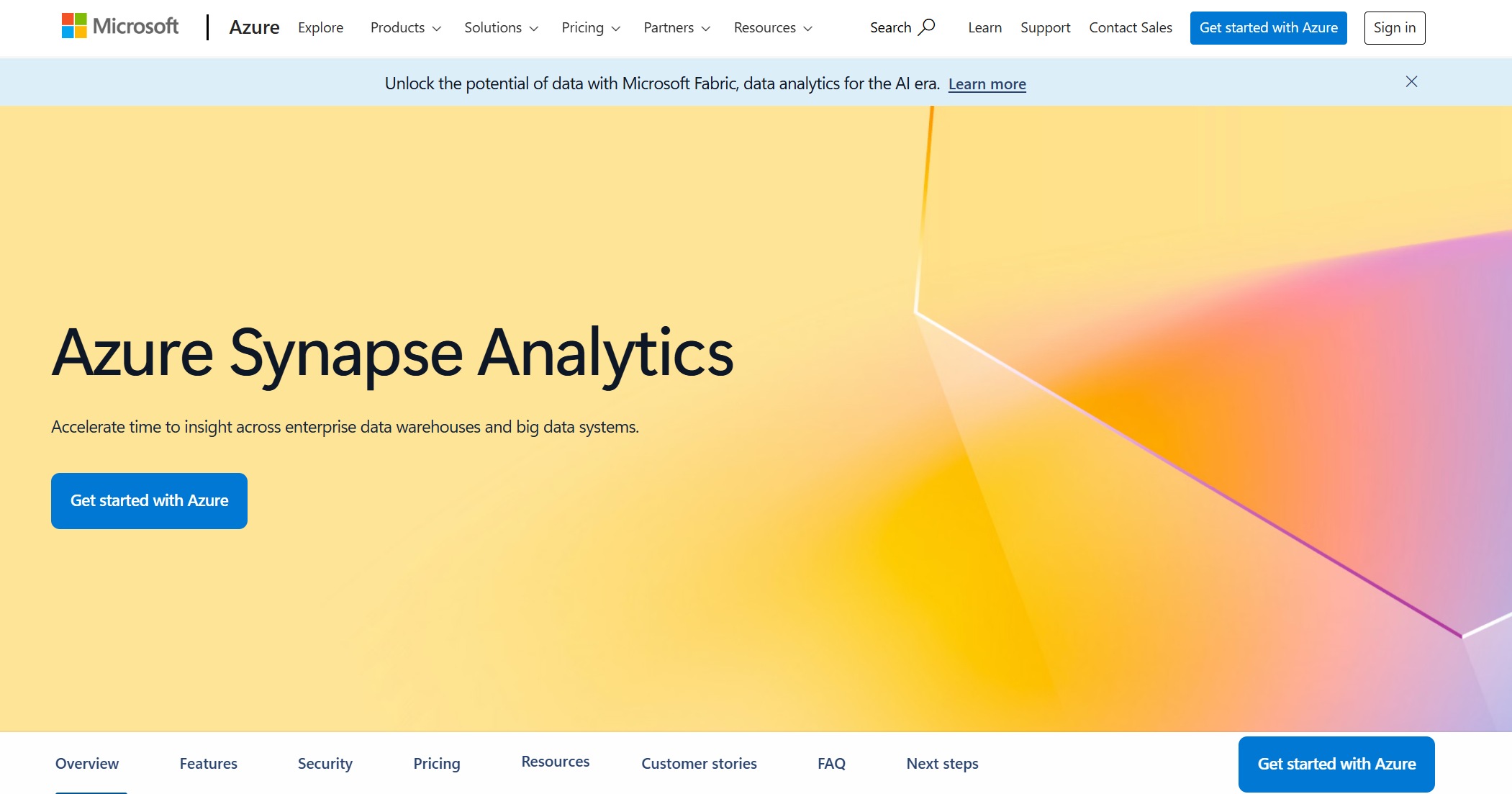
Website: https://azure.microsoft.com/en-us/products/synapse-analytics
Key Features
Microsoft Azure Synapse Analytics offers a comprehensive solution for managing and analyzing data across various systems. Its standout features include:
- Seamless integration with data warehouses and lakes, enabling unified insights.
- Near-real-time analytics by connecting operational databases with applications.
- Advanced security features like automated threat detection to protect sensitive data.
- Collaboration tools that bring together data engineers, scientists, and analysts.
- A flexible pay-as-you-go pricing model that ensures cost efficiency.

Benefit Description
- Gain insights across various data systems, including data warehouses and lakes.
- Reduce development time and facilitate data sharing with minimal effort.
- Enable collaboration among data engineers, administrators, scientists, and analysts.
- Obtain near-real-time insights by integrating operational databases with applications.
- Ensure data security with advanced features like automated threat detection.
- Utilize a flexible pay-as-you-go pricing model for cost efficiency.
Use Cases
Azure Synapse Analytics excels in industries requiring real-time insights and collaboration. Retailers use it to analyze customer behavior and optimize inventory. Financial institutions rely on it for fraud detection and risk modeling. Healthcare providers leverage its capabilities for patient data analysis and predictive healthcare solutions.
Pros and Cons
Pros:
- Unified platform for data integration and analytics.
- Advanced security features for compliance and data protection.
- Scalable and cost-effective pricing model.
Cons:
- Steep learning curve for new users.
- Requires expertise to fully utilize its advanced features.
8.Snowflake
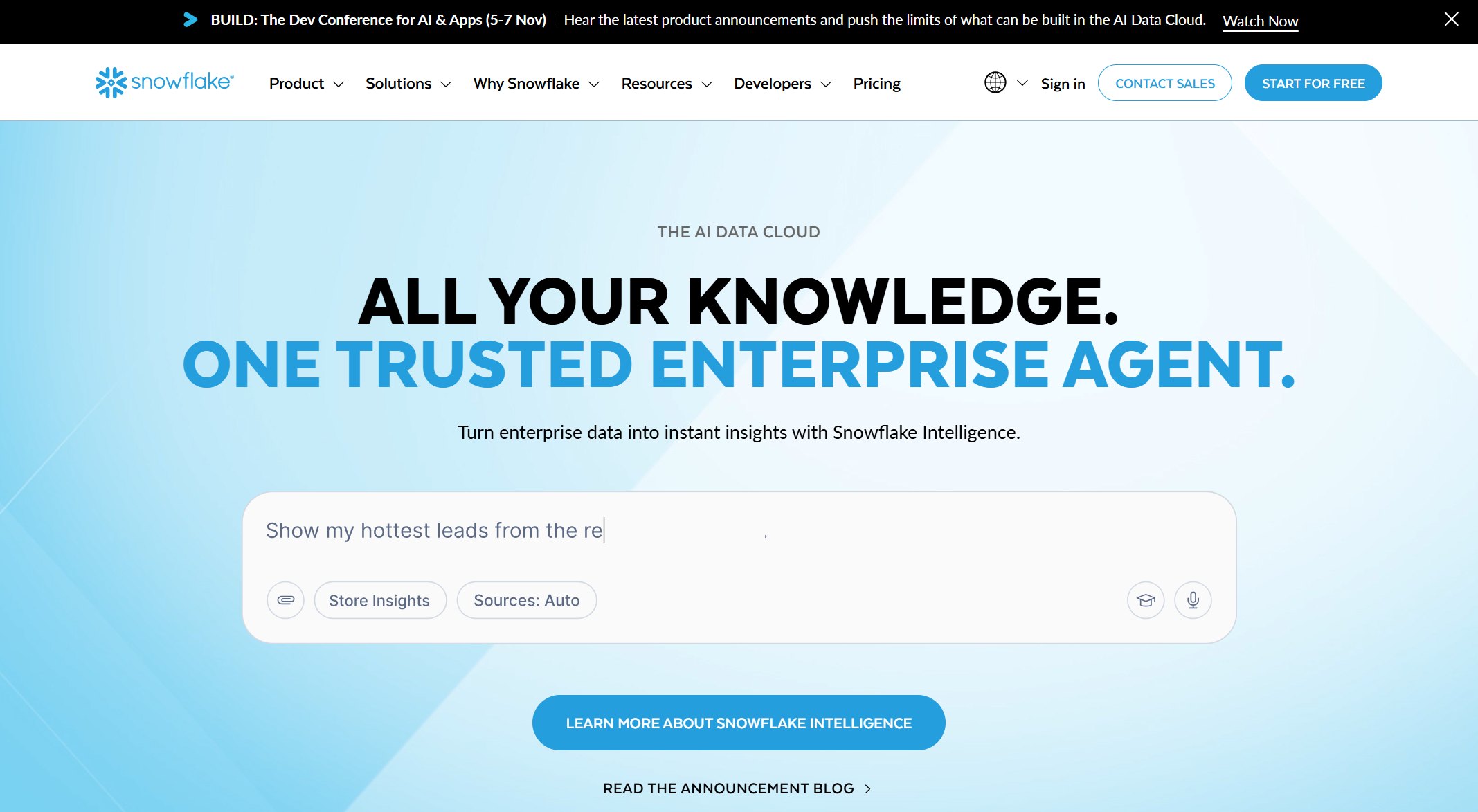
Website: https://www.snowflake.com/en/
Key Features
Snowflake stands out for its performance and simplicity in big data analytics. Its key features include:
- Auto-scaling clusters that handle multiple workloads without performance interference.
- Caching mechanisms that reduce latency and improve query speed.
- Support for structured and semi-structured data, ensuring flexibility.
- Seamless integration with popular data analytics tools for visualization and reporting.
| Performance Aspect | Snowflake Performance Description |
|---|---|
| Query Speed | Can process large datasets (e.g., 10 billion rows) in under 10 seconds with appropriately sized resources. |
| Latency | Simple queries yield results in less than 5 seconds, enhanced by caching mechanisms. |
| Workload Management | Auto-scaling clusters allow multiple workloads to run concurrently without performance interference. |
Use Cases
Snowflake is widely used in e-commerce for customer segmentation and personalized recommendations. Marketing teams rely on it for campaign performance analysis. Financial institutions use it for risk assessment and compliance reporting. Its ability to handle large datasets quickly makes it ideal for businesses requiring fast insights.
Pros and Cons
Pros:
- Exceptional query speed and low latency.
- Auto-scaling capabilities for efficient workload management.
- User-friendly interface suitable for non-technical users.
Cons:
- Costs can escalate with high query volumes.
- Limited offline functionality.

9.Cloudera Data Platform
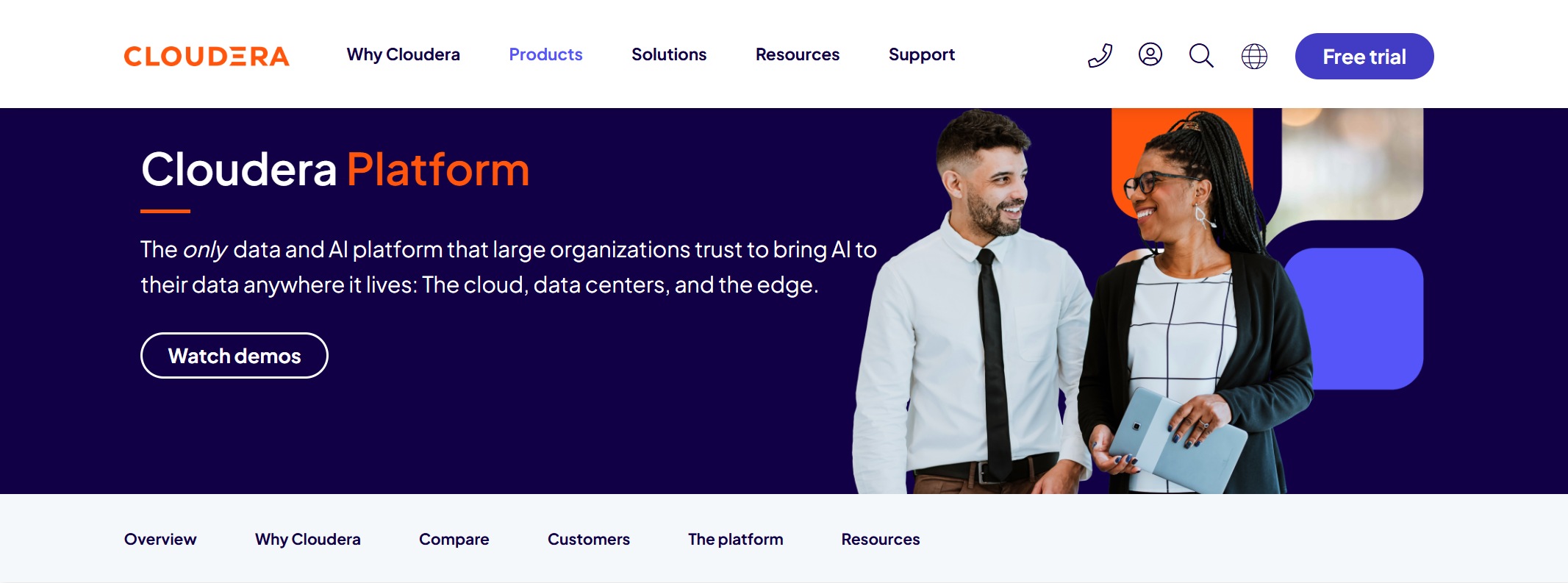
Website: https://www.cloudera.com/products/cloudera-data-platform.html
Key Features
Cloudera Data Platform (CDP) provides a unified architecture for managing and analyzing data. Its key features include:
- Scalability to handle exponential data growth.
- Integrated tools for data engineering, machine learning, and operational database management.
- Advanced security and compliance features for data protection.
- Support for hybrid and multi-cloud environments, ensuring flexibility.
Use Cases
CDP is ideal for businesses managing diverse data workloads. Retailers use it for supply chain optimization and customer behavior analysis. Healthcare organizations rely on it for predictive analytics and patient data management. Its machine learning capabilities make it a favorite for industries exploring AI-driven insights.
Pros and Cons
Pros:
- Unified platform for diverse data analytics needs.
- Strong security and compliance features.
- Scalable architecture for growing data demands.
Cons:
- High initial setup costs.
- Requires technical expertise for optimal use.
Which of these big data platforms aligns with your business needs? Share your thoughts in the comments below!
10.Splunk

Website: https://www.splunk.com/
Key Features
Splunk is a leading platform in big data analytics, offering innovative features that simplify data management and enhance processing efficiency. Some of its standout features include:
- Pipeline Builders: These tools allow you to filter, mask, transform, and enrich data, reducing processing complexity and costs.
- Ingest Processor: This feature unifies data management across Splunk platforms, converting logs into metrics for better volume control.
- Federated Analytics: It enables you to analyze data from both Splunk and external data lakes, improving accessibility and decision-making.
These features make Splunk a versatile choice for businesses aiming to streamline their data workflows and gain actionable insights.
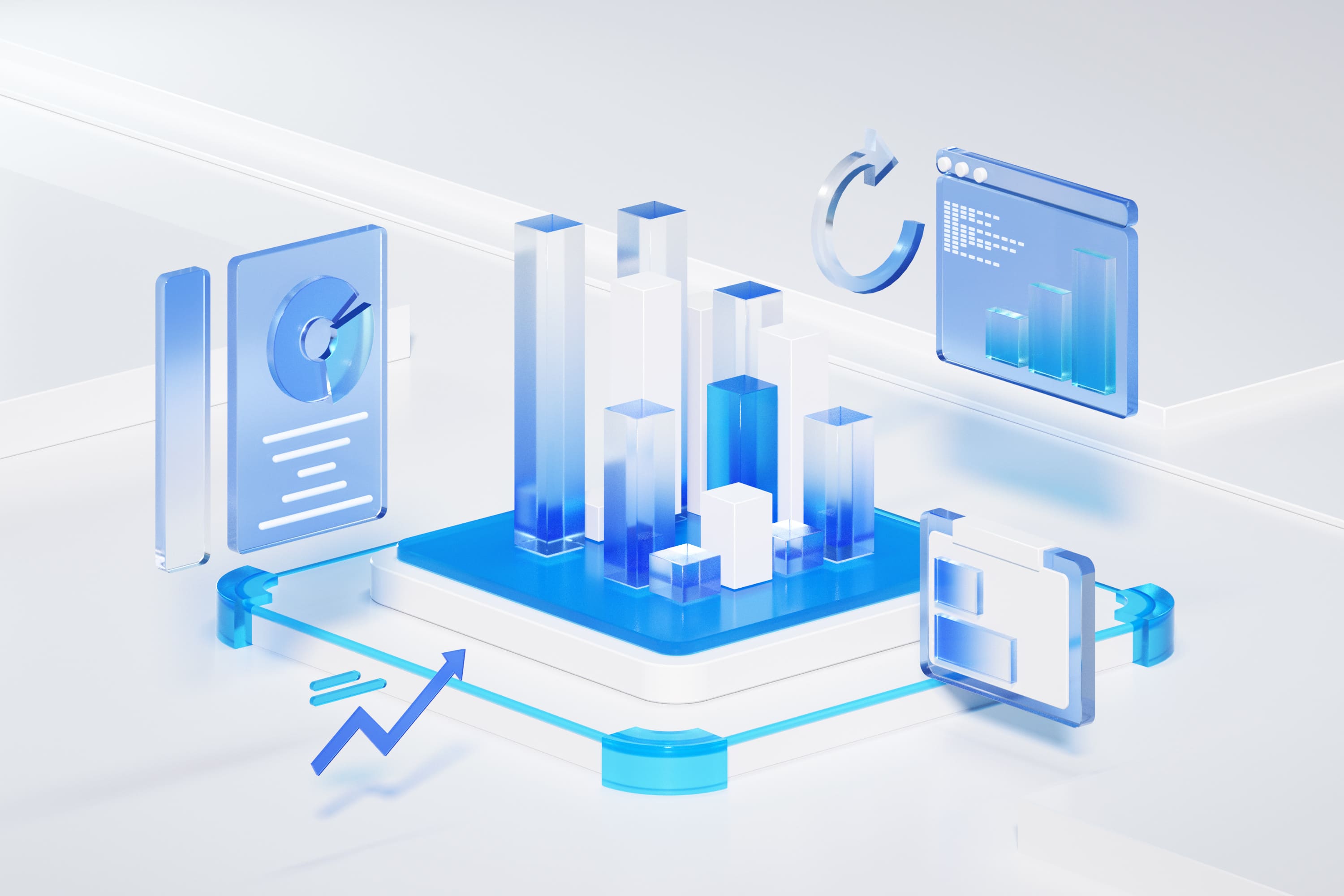
Use Cases
Splunk excels in industries that require real-time data analytics. IT teams use it for monitoring system performance and detecting anomalies. Retailers rely on it to analyze customer behavior and optimize inventory. In cybersecurity, Splunk helps identify threats by analyzing large volumes of security data. Its ability to handle diverse data sources makes it a valuable tool for organizations across various sectors.
Pros and Cons
Pros:
- User-friendly interface suitable for both technical and non-technical users.
- Strong capabilities for real-time data processing and visualization.
- Extensive integration options with third-party tools.
Cons:
- High licensing costs may deter small businesses.
- Requires expertise to fully utilize advanced features.
Splunk’s innovative features and flexibility make it a top contender among big data platforms. How do you see it fitting into your business needs? Share your thoughts below!
New Technology Trends and Development Forecasts
The landscape of big data platforms is evolving rapidly in 2025. Several trends are shaping the future of data analytics:
- Data Lakehouses: These systems combine the flexibility of data lakes with the reliability of data warehouses, offering a unified solution for managing structured and unstructured data.
- Open Table Formats: Technologies like Apache Iceberg are becoming essential for efficiently managing large-scale tabular data.
- Quantum Computing Preparations: Organizations are beginning to explore quantum computing to solve complex data processing challenges.

Additionally, three key developments are expected to dominate:
- Catalog Wars: Companies will focus on interoperability and governance in hybrid and multi-cloud ecosystems.
- Observability-Driven Development: This approach will prioritize monitoring and analyzing application performance during development.
- Streaming Data Platforms: These platforms will become critical for managing the growth of observability and security data.
These trends highlight the importance of staying updated with cutting-edge technologies. By adopting these advancements, you can ensure your business remains competitive in the ever-changing world of big data analytics.
What trends do you think will have the biggest impact on your industry? Let us know in the comments!
How to Choose the Right Big Data Platform or Tool
Identifying Your Business Needs
Choosing the right big data platform starts with understanding your business requirements. For businesses seeking a balance of affordability, scalability, and user-friendliness, FineBI is an excellent choice. Its ability to integrate with existing systems and provide real-time insights makes it ideal for industries like finance, retail, and logistics.
Begin by assessing your current enterprise architecture. Identify how your existing systems handle data flow and pinpoint areas where integration is necessary. Next, define your business objectives and the specific problems you aim to solve with big data analytics. For example, are you looking to improve customer segmentation, optimize supply chains, or enhance real-time decision-making? Once you have a clear picture, align these needs with the features offered by big data platforms. Look for platforms that support your technical requirements and offer scalability for future growth.
Tip: Clearly defining your goals ensures that the platform you choose aligns with your long-term strategy.
Evaluating Scalability and Performance
Scalability and performance are critical factors when selecting a platform. You need a solution that can handle increasing data volumes without compromising efficiency. Evaluate the platform's ability to manage data growth, its throughput, and latency. Check if it offers elasticity features like auto-scaling, which adjust resources based on demand. Additionally, consider infrastructure flexibility. A platform that operates across various environments, such as cloud, on-premises, or hybrid systems, ensures adaptability to your evolving needs.
| Factor | Description |
|---|---|
| Data Volume Management | Assess how well the platform handles increasing data volumes without performance degradation. |
| Performance Metrics | Evaluate throughput and latency to ensure stable performance as the system scales. |
| Infrastructure Flexibility | Check if the platform can operate across various environments and adapt to changing needs. |
| Cost Efficiency | Analyze the pricing model to ensure it remains cost-effective as data volume grows. |
| Elasticity Features | Look for auto-scaling capabilities that adjust resources based on current demand. |
Considering Budget and Cost Constraints
Budget plays a significant role in your decision. Cloud-based platforms often provide flexible pricing models, allowing you to pay only for the resources you use. This approach minimizes upfront costs and makes scaling more affordable. However, you should also evaluate the total cost of ownership, including licensing fees, infrastructure investments, and maintenance expenses. Platforms that integrate data analytics tools can save you money by streamlining workflows and reducing operational costs. Always balance cost with the platform's ability to meet your business needs effectively.
Remember: A cost-effective platform doesn't just save money—it also delivers value by enhancing your data analytics capabilities.
Prioritizing Ease of Use and Support
Ease of use plays a critical role when selecting big data platforms. A platform with an intuitive interface allows you to focus on insights rather than struggling with technical complexities. Look for features like drag-and-drop functionality, customizable dashboards, and clear navigation. These elements simplify data analytics, making it accessible even for non-technical users. Platforms like Tableau and Snowflake excel in this area, offering user-friendly designs that reduce the learning curve.

Support is equally important. Reliable customer service ensures you can resolve issues quickly, minimizing downtime. Evaluate the platform’s support options, such as live chat, email, or dedicated account managers. Comprehensive documentation, tutorials, and active user communities also enhance your experience. For example, Splunk provides extensive resources and forums where users share solutions and best practices.
Tip: Prioritize platforms that offer both ease of use and robust support. This combination ensures you can maximize the value of your big data analytics efforts without unnecessary hurdles.
How do you balance ease of use and support when choosing a platform? Share your thoughts in the comments below!
Testing Platforms and Tools with Free Trials
Testing platforms through free trials is a smart way to evaluate their capabilities. Most big data platforms offer trial periods, allowing you to explore features and assess performance. Use this opportunity to test scalability, speed, and integration with your existing systems. For instance, try running a real-time data analytics task to see how the platform handles large datasets.
Focus on user experience during the trial. Assess how intuitive the interface feels and whether the platform meets your specific needs. Experiment with key features like data visualization, machine learning integration, or real-time processing. Platforms like Google BigQuery and Microsoft Azure Synapse Analytics often provide trial versions that showcase their advanced capabilities.
Note: Keep track of any limitations during the trial, such as restricted access to premium features or limited data storage. These factors can influence your final decision.
Have you tried free trials for big data tools? What features stood out to you? Let us know in the comments!
Big data platforms and tools are essential for driving innovation and smarter decision-making in 2025. They enable you to transition from reactive to proactive strategies, helping you anticipate customer needs and gain a competitive edge. Exploring platforms like Snowflake or Apache Spark ensures your business aligns with its unique goals. Staying informed about trends like real-time data processing and AI-driven analytics keeps you ahead in the evolving landscape of big data analytics. By adopting a strategic approach, you can unlock the full potential of these transformative technologies.
Click the banner below to experience FineBI for free and empower your enterprise to convert data into productivity!
Continue Reading About Data Analysis
Why Care About Data Platforms? Find Out Here!
Understanding Descriptive Analytics: What It Is and How It Works
Step-by-Step Guide to Setting Up a Data Analytics Framework
Write a Killer Visual Analysis Essay in 2025!
FAQ

The Author
Lewis
Senior Data Analyst at FanRuan
Related Articles

10 Best Retail Analytics Software Platforms for Retailers
Compare the 10 best retail analytics software platforms for retailers to boost sales, optimize inventory, and gain actionable customer insights.
Lewis
Dec 16, 2025
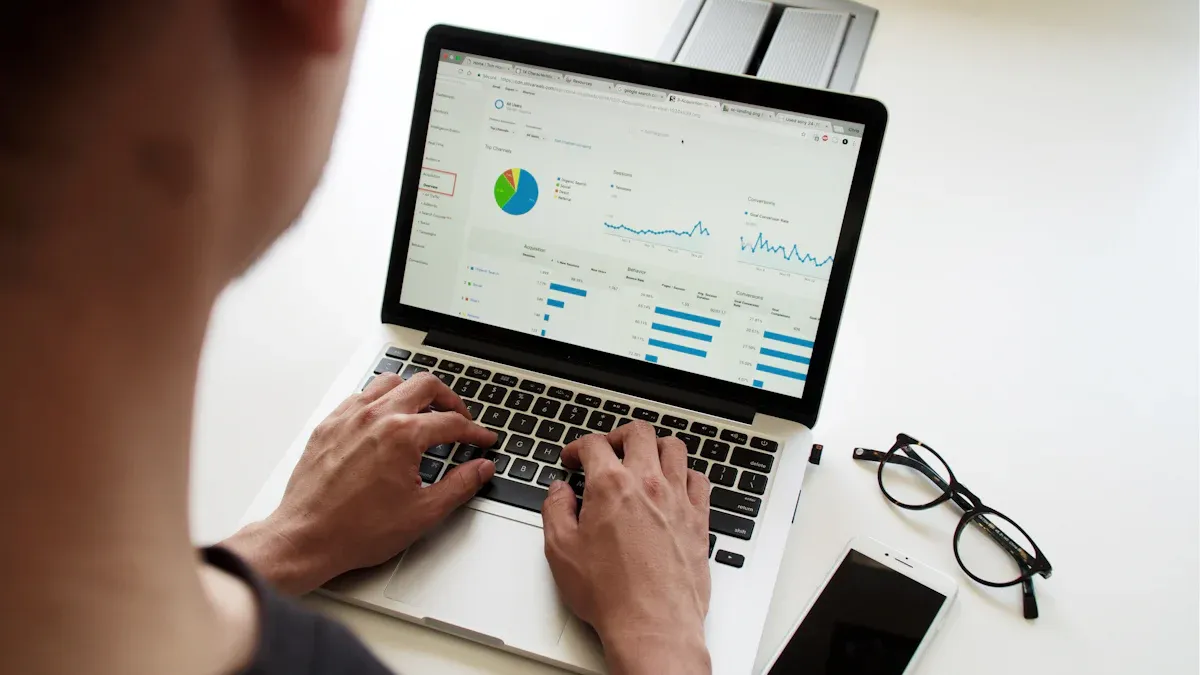
11 Best Tools for Research Analysis for Academics
Compare the 11 best tools for research analysis to boost academic and professional research efficiency, data management, and collaboration.
Lewis
Dec 11, 2025

10 Best Market Research Data Analysis Tools to Try This Year
See the top 10 market research data analysis tools to boost insights, streamline workflows, and make smarter business decisions this year.
Lewis
Dec 11, 2025




